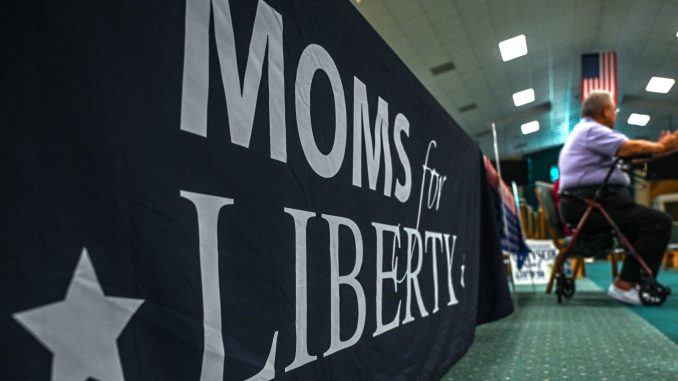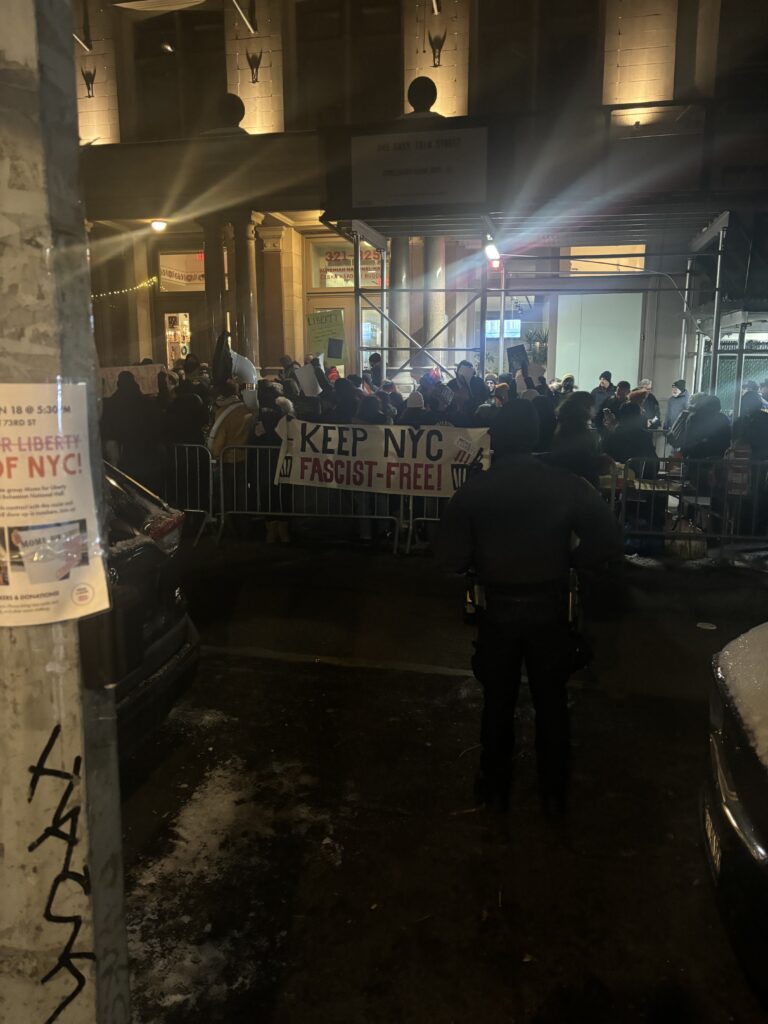
Moms for Liberty held an event in New York City on Thursday night to discuss and diagnose the woeful state of education in the Big Apple.
Residents and local representatives were invited to take part in the education organization’s town hall on the Upper East Side and the follow-up discussion.
Moms for Liberty has been treated with hostility by left-wing groups in the city, so it was a full house for the event—not just inside the building, but outside, too.
A gaggle of protesters showed up to crowd the front of the building and chant slogans. The New York Police Department kept watch at the entrance and helpfully guided me to the door.
The protesters held up a large sign “Keep NYC Fascist-Free!” as they blockaded the door and yelled at the people going inside.

One of the speakers at the outside protest, who was invited to speak at the event inside, was Manhattan Borough President Mark Levine.
“This group is anti-LGBTQ, supports book bans, harasses teachers & school librarians, and has been labeled by [the Southern Poverty Law Center] a ‘far-right extremist organization,’” Levine wrote in a statement before the event took place.
As I left the event, one of the demonstrators—in a pink unicorn costume—followed me down the street.
I was able to snap a picture of this person when I stopped and she/he/they/them—or whatever it was—said, “We don’t like you. You smell.” Needless to say, this was not the beginning of a Socratic dialogue.
I live in New York, so I’ve definitely been followed by much worse, but all I could think was: “That’s the best line you could come up with?”
For what it’s worth, the person in the pink unicorn costume was apparently not a “furry,” according to internet trolls. My apologies for not knowing the difference.
As for the actual event, the following are some of my takeaways from a panel discussion about the problems with New York City schools.
Poor Return on Education Investment
Moms for Liberty co-founder Tiffany Justice led a panel discussion about how New York City schools have failed children and parents alike.
“A third of the kids in the United States are reading on grade level. That’s atrocious, but here in New York City, where you spend about $40,000 a year on each child’s education, only a quarter of the children are reading on grade level,” she said in opening remarks.
Justice said that in New York, black and Hispanic students are particularly struggling, as only 13 in 100 are proficient in reading. That’s despite the New York City school district spending the most money per student compared with any other district in the nation.
Justice contrasted New York City’s record against that of Miami, which spends $11,000 per student, yet “40 out of 100 fourth graders are reading and math proficient.” She said that’s nothing to brag about, “but for heaven’s sake, right?”
The Moms for Liberty co-founder said that the results in New York City schools were declining even before the COVID-19 pandemic lockdowns, but there was a complete collapse during and afterward.
Misguided Focus on Identity Over Merit
Wai Wah Chin of the Chinese Americans Citizens Alliance of Greater New York spoke about how a focus on “equity” has moved the school system away from evaluating the individual skills and talents of students.
“Our schools should be providing the best education for the children as they are, and that means you cannot dispel and get rid of merit,” she said. “Merit must exist, because if you do not have merit, you do not have good education.”
Chin explained that she was referring specifically to academic merit—“reading, writing and arithmetic.”
“If you can’t do that, you’ve failed as a school,” she said.
Teaching students to be activists first before teaching students to think—Chin cited the people protesting outside—is a failure of education, she added.
“If you do not respect facts, and you do not respect logic, you are not capable of making the decisions that are important for yourself in life and in the world,” she continued. “And that’s what our schools must do: Provide that kind of environment so that you have facts and not ideology.”
Paul Rossi, a New York City teacher, followed up on Chin’s comments about ideology in the school system. He spoke about his previous teaching experience at Grace Church School, an elite New York private school.
He said that the school pushes ideas such as “anti-racism, critical race theory, gender ideology, these progressive beliefs, which have really come through the universities and dominated education, because most of the people who go through the [education] schools and teachers are inculcated in these ideas.”
Rossi said that he teaches math, but that the ideology that dominates in schools denies that objectivity exists and calls objectivity an element of white supremacy.
He said that he has seen a shift away from building character to a focus on group identity.
‘Fund Students, Not Systems’
Corey DeAngelis, the executive director of the Education Freedom Institute, spoke about policy solutions that could improve education in New York City.
He explained that New York has a cap on the largely successful charter schools because “the Democratic Party is owned by the teachers unions. It’s that simple.”
Almost all the political campaign contributions from teachers unions go to Democrats, DeAngelis said, and that constitutes a “nonstop money-laundering operation.”
He said that while New York is dominated by this political dynamic, there’s been a sea change in other states because teachers unions have overplayed their hand and “awakened a sleeping giant” of parents.
That has led to parents pulling money out of failing public schools and creating school choice programs, he explained. “We should fund students, not systems,” he said.
The education scholar spoke about how states such as Arizona have created Education Savings Accounts and other programs that have allowed parents to directly pay for the education they want for their child, whether that be a public school, a private school, a charter school, or a home-based education.
“The money follows the child,” he explained.
It’s Worse Than You Think
Nicholas Giordano, a professor of political science at Suffolk County Community College, spoke about how the education system has been transformed and how “it’s 10 times worse” than what most people think.
He said that in his two decades of teaching, he’s noticed a pattern that students increasingly don’t have the knowledge they need when they enter higher education.
He said that he began instituting a citizenship exam on basic civics and history questions when students took his classes. He said that very few pass it.
“Students aren’t learning. They are simply being cycled through the system,” he said.
Giordano said that, according to national assessments, only 13% of students are proficient in history and just 23% are proficient in civics.
He said that this failure has been the product of two main problems. The first is that parents became less involved in their children’s education. In many cases, both parents are working or the child comes from a single-parent household.
He said that began to change during the COVID-19 lockdowns when the “veil” was lifted, and parents saw what was being taught in classrooms as a result of the switch to online instruction. Many people saw for the first time the “anti-Americanism” that has crept into K-12 instruction, he said.
That’s a huge problem, Giordano said, because as the Founding Fathers insisted, our “small-r” republican institutions must be nourished by an education grounded in furthering those institutions.
“Our education system should be linking us together. Instead, it divides us,” he said.
Have an opinion about this article? To sound off, please email letters@DailySignal.com, and we’ll consider publishing your edited remarks in our regular “We Hear You” feature. Remember to include the URL or headline of the article plus your name and town and/or state.

